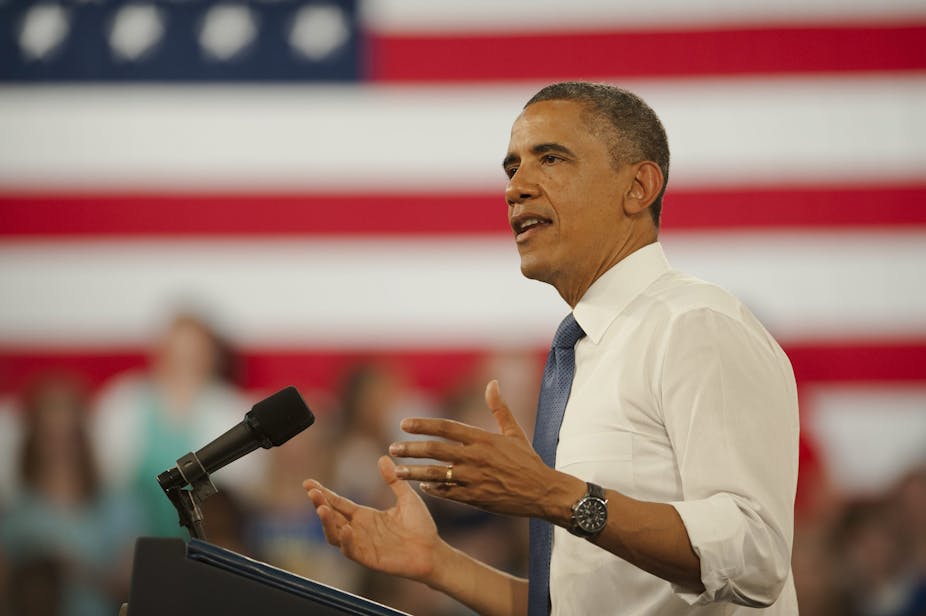Barack Obama’s State of the Union address last week was important for both policy and political reasons. In it, Obama argued for a more egalitarian “middle-class economics”. In the process, he prepared the ground for the anticipated 2016 Hillary Clinton presidential campaign and began to force the Republicans further to the right.
It also didn’t hurt that Obama seemed to have the Republicans’ psychological number: When the assembled Republican legislators cheered his observation that he had “no more campaigns to run”, he baited them in reply, “I know because I won both of them.”
But more was going on in this address than just political one-upmanship. In policy terms, the 2015 State of the Union can be seen as representing Obama’s first post-Global Financial Crisis address.
Consider that following six years dominated by efforts to recover from the GFC, the US has finally begun to approach full employment: 2014 was the best year for hiring in 15 years. In January 2015 the jobless rate hit 5.6%. By comparison, in 2014, Australian unemployment continued its steady increase, reaching 6.1% in December 2014.
This shift was evident in Obama’s State of the Union rhetoric. In the immediate aftermath of the GFC, Obama had faced a rhetorical policy dilemma.
On the one hand, he campaigned in 2008 on a platform of reform. Indeed, as the economy continued its early-2009 freefall – with more than 800,000 jobs lost in January 2009 alone – Obama essentially “doubled down” in rhetorical terms. For example, after revelations of executive pay abuses at firms like AIG - which had received billions in government aid - Obama urged caps on executive pay and an array of controls.
On the other hand, he also would grow concerned that such initiatives might threaten the confidence necessary for recovery. So he ultimately held back on many of his promised reforms. In short, Obama was worried about economic confidence and repeatedly warned that any reforms must – as he put it in April 2009 at Georgetown University – “do no harm” to recovery.
Six years of struggle, however, do make a difference. With the US economy back on its feet, the Obama of 2015 has returned to his earlier reformist stance. This was reflected in his State of the Union assertion that “we need to set our sights higher than just making sure government doesn’t screw things up … We need to do more than just do no harm.”
No longer does the need to “do no harm” translate into an aversion to doing anything at all.
The Australian parallels
In policy terms, this led Obama to issue his State of the Union call for a “middle-class economics”. He defined this agenda more specifically as embodying a stress on services for “working families” - a phrase used with much success in 2007 by Kevin Rudd.
Giving meaning to this notion, Obama unveiled a package of middle-class-focused reforms: these encompassed subsidies for childcare, provisions for maternity and sick leave, a plan to make community college free, and infrastructure investment. All told, Obama proposed US$235 billion in new spending, to be funded through US$320 billion in tax increases.
These proposals are unlikely to get through the Republican-controlled congress. In this light, one might ask: what’s the point? While Obama may eke out a bit of legislation, his dual concerns are best seen as pre-positioning the Hillary Clinton campaign for a centrist offensive, while driving the Republican Party to the right.
Indeed, it is a time-honoured process, one Hillary herself no doubt appreciates. In the 1992 campaign, following decades in which the Democratic Party had been seen as a party of “special interests”, Bill Clinton succeeded in recasting his party as one that would “put people first” – and so defend the middle class against pro-business Republicans. Only a year later, Paul Keating would ride a similar tack to victory over John Hewson’s ideological Fightback! package. Four years later and Tony Blair would similarly box out British conservatives.
In turn, in this light, Obama can be seen as seeking to drive a wedge between moderate, pro-business Republicans and their Tea Party brethren. Having occupied the middle, he now seeks to fracture the opposition. Indeed, initial Republican reactions to the address would suggest that he is succeeding. Not only Tea Party types but also party moderates moved to condemn his appeals as divisive.
Moderate front-runner Jeb Bush lamented: “It’s really sad that President Obama wants to use the tax code once again to divide us.” Mitt Romney likewise condemned “bridge to nowhere’ proposals”. Tea Party favourite Rand Paul offered a sharper critique, suggesting that: “The President is intent on redistributing the pie, but not growing it.”
While each of these stances may please the party faithful, they may lack broader resonance. This helps explain why Hillary Clinton continues to lead every likely Republican challenger in recent polls.
In short, two years is a long time in politics, but Obama’s 2015 State of the Union address provides a policy foundation for political success in 2016.

